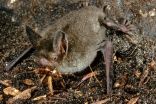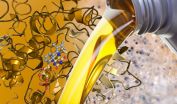(Press-News.org) San Diego, June 17 -- A team of researchers led by bioengineers at the University of California, San Diego provide new insights on how hearts 'stay young' and keep functioning over a lifetime despite the fact that most organisms generate few new heart cells. Identifying key gene expression changes that promote heart function as organisms age could lead to new therapy targets that address age-related heart failure.
The researchers found that the contractile function of the hearts of fruit flies is greatly improved in flies that overexpress the protein vinculin, which also accumulates at higher levels in the hearts of aging rats, monkeys and humans. In addition, flies genetically programmed to express elevated levels of vinculin lived significantly longer than normal fruit flies. The new study attributes the longer life of the flies to the improved contractile function of the heart due to the presence of more vinculin, which helps with the structure of the heart and connects heart muscle cells.
This work is published in the June 17 issue of Science Translational Medicine.
Heart disease is the leading cause of death globally and advanced age is a primary risk factor.
'With the average age being projected to increase dramatically in the coming decades, it is more important than ever that we understand and develop therapies for age-related heart failure,' said Adam Engler, a bioengineering professor at UC San Diego and senior author on the paper. 'The results of this study implicate vinculin as a future candidate for therapy for people at risk of age-related heart failure.'
For example, if additional research supports these new findings, targeted gene or drug therapies related to vinculin and its network of proteins could be developed to strengthen the hearts of patients suffering from age-related heart failure.
'More than 80 percent of protein groups found in flies, including vinculin network proteins, are similar to those found in rats and monkeys,' said Gaurav Kaushik, lead author on the study. He worked on this project as a bioengineering Ph.D. student in Engler's lab at UC San Diego and is now a postdoctoral researcher at Harvard Medical School. 'We chose to focus on the proteins that naturally increase in expression in the aging hearts of flies, rats and monkeys. Since deletion or mutation of these proteins can lead to cardiomyopathy in patients, we wondered if their age-related upregulation was beneficial to the heart. Moreover, would overexpressing them improve heart function?'
Kaushik and colleagues genetically modified fruit flies to overexpress proteins, including vinculin.
Remodeling the heart
The human heart is capable of functioning for decades despite the fact that few new heart cells are generated over the course of a lifetime, indicating that alterations in gene expression, known as 'remodeling events' help to maintain heart function with age.
'Because renewal of heart cells is limited, maintenance of the heart may depend on remodeling events over time,' said Engler. 'Identifying which events are conserved within and between organisms and which result in improved heart function is difficult but could be incredibly valuable.' That's one of the tasks the researchers set out for themselves. Engler continues, 'Within any muscle, the contractile structures become more disordered with age. In heart muscle, vinculin is needed to preserve that structure by holding it together. By performing a kind of open-heart surgery on the flies that overexpressed the protein, we were able to see that the longer life of these flies was due to improved heart muscle function.'
In the study, 50 percent of vinculin-overexpressing flies lived past 11 weeks, to a maximum of 13 weeks. In contrast, 50 percent of control flies only made it to four weeks old and none lived past eight weeks.
'Fruit flies only live for a few weeks which makes them an ideal model for studying aging,' Engler explained.
High school students play a role
Near the beginning of the study, Kaushik and Engler began an outreach effort with a local high school class in San Diego. Kaushik tasked the students with a small pilot study in which they monitored the genetically modified fruit flies over a period of six weeks. Jesse Robinson is a biology teacher at Gary and Jerri-Ann Jacobs High Tech High Charter School. Each year, Robinson's junior-level biology class works with local scientists on a project.
'Project based learning is part of the philosophy of the school,' said Robinson. 'The goal is to immerse students in authentic learning experiences with adult professionals to prepare them for college and career.'
Carl Shefcik, Madison Clark, Hannah Goodwin and Stephen To, now graduating seniors, were all part of Robinson's class in the Fall of 2013 when the project was assigned.
'We were divided into pairs and assigned two groups of fruit flies -- a control group, and a second strain containing one of the mutations that Dr. Engler's group identified,' said To.
'We didn't know which group was the control group, and which had the mutation,' recalls Sheficik. 'Because of that, we needed to make sure that we kept careful track of which flies died a natural death over a period of six weeks. We found that the group that overexpressed the protein vinculin were outliving the control group by about seven weeks - that's three times the normal lifespan of a fruit fly!'
The outcome was surprising to Engler and Kaushik, who as a result decided to expand the experiments to focus on vinculin for the study being published in Science Translational Medicine .
'As a teacher, it was neat to see the students tell a story with the data they collected,' said Robinson, who added that this is the first time one of these collaborations was associated with an academic paper. 'Dr. Engler was able to ask 'why' as a result of the students' explanation of the data.'
'The project drove my interest in a career in biology,' said Clark, who will attend Cal Poly Pomona in the Fall for biology with an emphasis in microbiology. 'It's really incredible to have participated as a high school student, and even more so to know that the research being done on vinculin could one day change lives. After all, that's what science is all about.'
Discoveries that change lives increasingly involve engineers.
'Life is complex, and everyone approaches it from a different viewpoint,' said Kaushik. 'Engineers may take notice of problems or solutions that a medical doctor may not. We're needed to accelerate healthcare solutions because we see them with a different set of eyes.'
INFORMATION:
Sydney, Australia - Fossilised remains of a new bat species, which lived 16 million years ago, walked on four limbs and was three times larger than today's average bat, have been discovered in New Zealand.
The fossils were found near Central Otago on South Island, in sediment left over from a vast prehistoric body of water known as Lake Manuherikia, which was part of warmer subtropical rainforest during the early Miocene era, between 16 and 19-million-years-ago.
The new species, Mystacina miocenalis, was described today in the journal PLOS ONE, and is related to another ...
In a finding that furthers the understanding of human immunodeficiency virus (HIV), researchers from Children's Hospital Los Angeles discovered two locations where a single difference in HIV's genetic code altered the way the virus infected the cell, thereby influencing the progression of the disease.
The results of this study will be published in PLOS ONE on June 17.
HIV targets specific white blood cells, called CD4+ T-cells, which play an important role in organizing the immune response to bacteria and viruses. By using two different receptors, CCR5 (R5) or CXCR4 ...
A new study led from Karolinska Institutet in Sweden links male infertility to autoimmune prostatic inflammation. The findings are published in the journal Science Translational Medicine.
Involuntary childlessness is common, and in half of all cases attributable to infertility in the man. Although male infertility has many possible causes, it often remains unexplained.
In the present study, the researchers have discovered a reason for reduced fertility in people with autoimmune polyendocrine syndrome type 1 (APS1), which increases the risk of developing autoimmune ...
BOSTON -- A new drug screening technology developed at the Harvard T.H. Chan School of Public Health has identified a new potential anti-diabetes compound--and a powerful way to quickly test whether other molecules can have a positive effect on a critical molecular pathway believed to be central to diseases ranging from diabetes to retinitis pigmentosa, cystic fibrosis, Huntington's disease, and Alzheimer's.
The study appears in the June 17, 2015 issue of Science Translational Medicine.
The compound, which the authors have called azoramide*, works by focusing on an ...
Scientists at the Charité - University Medicine Berlin, Department for General, Visceral and Transplantation Surgery, led by Dr. Georg Damm (and Prof. Dr. Daniel Seehofer) have established a protocol for an uncomplicated isolation of primary human hepatocytes (PHH), Kupffer cells (KC), liver endothelial cells (LEC), and human Stellate cells (HSC) from human donor tissue. Liver cells were isolated from the tissue using a two-step EDTA/collagenase perfusion technique, followed by a separation of PHH and different non-parenchymal cell (NPC) fractions through Percoll density ...
This Week From AGU: Gender parity in the geosciences, Tibetan Plateau formation
From eos.org: Working Toward Gender Parity in the Geosciences
How are women represented in the geosciences? The author of a new AGU book, Women in the Geosciences: Practical, Positive Practices Toward Parity, answers some questions.
From AGU's journals: Dynamics of the Earth's Surface in the Eastern Tibetan Plateau
The evolution of mountains is written in the histories of the rocks that make up their ranges. Scientists have long used areas where rivers cut deep incisions in rock ...
Scientists at The University of Manchester have made an important discovery that forms the basis for the development of new applications in biofuels and the sustainable manufacturing of chemicals.
Based at the Manchester Institute of Biotechnology (MIB), researchers have identified the exact mechanism and structure of two key enzymes isolated from yeast moulds that together provide a new, cleaner route to the production of hydrocarbons.
Published in Nature, the research offers the possibility of replacing the need for oil in current industrial processes with a greener ...
The moon is engulfed in a permanent but lopsided dust cloud that increases in density when annual events like the Geminids spew shooting stars, according to a new study led by University of Colorado Boulder.
The cloud is made up primarily of tiny dust grains kicked up from the moon's surface by the impact of high-speed, interplanetary dust particles, said CU-Boulder physics Professor Mihaly Horanyi. A single dust particle from a comet striking the moon's surface lofts thousands of smaller dust specks into the airless environment, and the lunar cloud is maintained by ...
In a remarkable demonstration of the curative power of memory, published in Nature, scientists have established that artificial reactivation of memories stored during a positive experience can suppress the effects of stress-induced depression. The research, conducted by scientists at the RIKEN-MIT Center for Neural Circuit Genetics, a joint collaboration of RIKEN Brain Science Institute in Japan and MIT, shows how positive and negative memories interact in mood disorders, and provides a specific brain circuit for future clinical interventions.
The research, conducted ...
BUFFALO, N.Y. - Sit down with a friend in a quiet restaurant and begin talking, just before the dinner crowd's arrival. Business is slow at first, but picks up quickly, just like the sound level. Music plays, glasses clink, servers discuss specials. Discussions are everywhere, colliding and competing with the other noises.
All of these sounds are hitting the eardrum at the same time, yet the initial conversation that began amidst surrounding silence continues easily because of a process that allows humans to isolate, identify and prioritize overlapping sounds.
Sometimes ...

